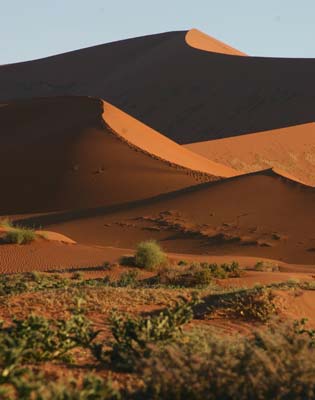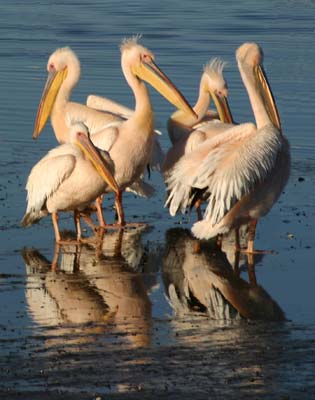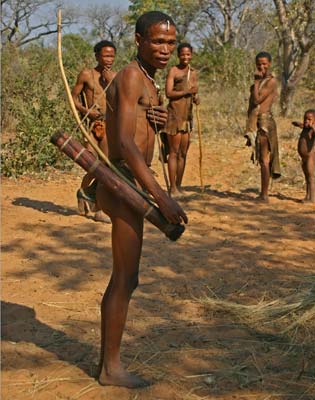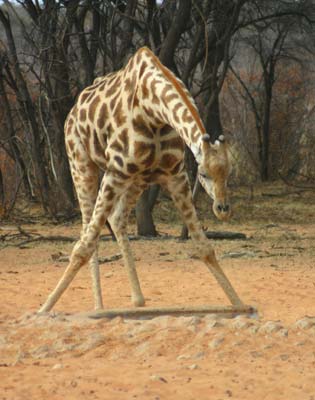Driving Namibia
by Joyce Bruck, Ocean Ridge, FL
My longtime friend Winnie Outcalt joined me in Johannesburg, South Africa, on August 18, 2006, for an adventure to Namibia. My interest in Namibia began when I saw pictures of the Skeleton Coast with its sand dunes, animals and shipwrecks. As I did my usual extensive research, I discovered there was so much to see, it was hard to decide what to include on our 2-week itinerary. I reserved tours online so I wouldn’t miss anything that was important to me.
Getting started
We arrived midday, tired but ready to explore. Our sedan from Avis (800/331-1212, www.avis.com) — $1,128 for two weeks — was waiting for us at the airport. It was a good thing we had reserved one because it was the popular “dry” season, when cars (and accommodations) were not easy to get. That said, the gravel roads we traveled on were deserted almost everywhere we went.
Through the Internet, I also had made all arrangements for hotels, lodges and guest houses. Planning our stops for each night as well as stops for food and gas proved to be critical since gas pumps were scarce.
Armed with two maps and a couple of guidebooks, we — two senior women — set out for the 45-minute drive to Windhoek, the capital of Namibia.
We located our pension, Villa Verdi (4 Verdi St.,), after searching a bit. One surprise — our room had no heat, as was the case in several other places we stayed. My Floridian blood was a little thin, so I was chilly since it was winter.
Both of us were tired from our long trip, so we decided to eat at the hotel. The dining room had a lot of atmosphere, and the food and service were excellent. We shared a fixed-price meal with an extra main course.
Since it was Winnie’s birthday, I bought her a glass of South African wine. When the bill came, I could not believe the wine had cost only one U.S. dollar! The price of our large double room plus dinner was $130.
The next morning we changed money at an ATM, bought water for the road in a supermarket and headed out for our hotel in the Namib Desert.
Sossusvlei and Walvis Bay
The Zebra River Lodge (fax +264 63 693266, www.zebrariver.com) is nestled in acres of tall bushman grass that grows in the colorful mountains and canyons on the lodge’s property. On the way in, we spotted several antelope, birds and baboons. The breakfast, lunch and dinner that were included with our room ($91 per day) were very good. Meals were served home-style, so we could have as much as we wanted.
The next day we took a full-day guided tour ($127 per person, booked at the lodge) through the Namib Naukluft Desert to Sesriem Canyon and Sossusvlei. Sossusvlei, with its colorful red-orange shifting sand dunes, was one of the more spectacular parts of the trip.
The guide spread out a picnic lunch of sandwiches, fruit, cookies and juice for us under the trees, where several unusual birds were perched. As the afternoon progressed, the shadows over the dunes made a beautiful setting sensational.
The next morning we were up early for a 9-hour drive through one of the oldest deserts in the world to the whaling/fishing village of Walvis Bay, dating back to the 1700s. The trip took us through unusual geological formations in Kuiseb Canyon and past antelope, ostriches and 600-year-old welwitschia plants.
In Walvis Bay we stayed for two nights at the 4-star Protea Hotel Pelican Bay (phone +27 21 430 5300, www.proteahotels.com), where a single room and buffet breakfast, including made-to-order omelets, cost $97 per night.
While Winnie spent time seeing the attractions of Swakopmund, I took a full-day guided tour of Sandwich Harbour with Turnstone Tours (Swakopmund; phone +264 64 403123, www.turnstone-tours. com). I was fortunate to have to myself a wonderful guide with a 4-wheel-drive for the whole day.
Driving out to the harbor, we passed numerous birds that the guide identified and I photographed. We also passed a saltworks area with huge piles of stark white sea salt, and high sand dunes ran right to the edge of the ocean. The beach was maroon from garnets, mixed with black from magnetite and quartzite.
In the morning I took a half-day boat trip ($53) with Mola Mola Safaris (fax +264 [0] 64 207 593, www. mola-namibia.com). In the bay we saw dolphins, an orca and a huge Cape fur seal colony. The seals were so friendly, they jumped on the boat and allowed people to pet them; kids even sat on their backs. Lunch on board was good, with sandwiches, fresh oysters and champagne.
Brandberg Mountains
Upon my return, Winnie and I jumped into the car for a long ride to the White Lady Lodge, our hotel for the night in the Brandberg Mountains. Although there are some good paved highways in Namibia, about 90% of our trip took us through rural areas with only gravel roads.
The roads were well marked in English, and with the help of my wonderful navigator and friend we never got lost. However, this section of the road was not well traveled and sand had accumulated along the tracks, causing the car to spin at one point. The rest of the way I slowed my speed and everything was okay.
It was dark by the time we reached the remote lodge, hidden among the high mountains. Our room was very basic, operating on solar power and not up to the standards of the rest on our trip. We waited hours for dinner.
The next day was to be one of the longest travel days of the trip, 10 hours. Twyfelfontain, one of the parks I wanted to visit, was on our way. We had hoped to see some of the 6,000-year-old petroglyphs there, but they were high up in the hills and we were pressed for time, so we settled for a short scenic walk.
On to Opuwo
The highway on which we were traveling was supposed to be passable all the way to Opuwo, but as we went farther we had to go through a small stream and a section where the road had washed out, leaving only rocks. We tried to pass, but the car would not move. For the only time during the trip I was slightly scared, though mostly just in a quandary.
After only a short time, two 4x4s with Italian tourists appeared. They built up the road for us with rocks under the tires, pushing from the rear while I slowly edged the car out by balancing the gas and clutch. I was very thankful!
The Okahane Lodge (phone +264 65 273031 or fax +264 65 273015), deep in the rural region of Kaokoland, was our next stop. Our rooms were small but well furnished and comfortable. It cost $114 for a nice single, breakfast, dinner and a visit to the Himba tribe, who live exactly as they have since they migrated from Angola some 300 years ago.
On our half-day private tour of the Himba village, we spent about two hours taking pictures of thatch huts, herds of cattle and goats, and women coating themselves with a red pigment, which protected their skin and kept insects away in addition to serving as a beautifying ointment. Watching their daily life was fascinating.
The remote town of Opuwo, located near the Angolan border, did not appear to be visited by many tourists. Women of the once-warlike Herero tribe, which came from East Africa in the 1500s, roamed the town in colorful long billowy dresses and wearing their typical boat-shaped hats. Some of the Himba people, dressed in their traditional outfits, also came to town for their supplies. It was fun to stand in line with the locals at the ATM machine.
Etosha National Park
After an overnight stop in Kamanjab at the Oase Guesthouse (fax +264 67 330032), which cost about $43 each for a single room, with dinner, we headed out for our big adventure, Etosha National Park, where we spent three nights in two of the three resorts within the park.
The most exciting thing about Etosha was being so close to wild animals. Zebras grazed by the side of the road, and elephants and giraffes came down the dirt road directly toward us. We watched as one of the 1,500 elephants in the park demolished a tree only yards from where we sat in the car.
The Okaukuejo Rest Camp is noted for its large permanent water hole that is lighted at night. At times there were no animals there, but at others there were hundreds. Mornings and evenings we watched the water hole, seeing zebras, oryx (gemsboks), giraffes, springbok and black-backed jackals all coming to drink. During the day we drove through the park on designated roads, but we had to stay in the vehicle and be back by sunset.
The Namutoni Resort had a German fort dating from the late 1800s, and some people stayed in its small rooms; we elected to stay in the section similar to a motel. There also were round villas available with rooms for families. For the four nights in Etosha we paid about $270, including the entrance fees to Etosha and Waterberg national parks. Food was extra. We booked the accommodations here through Namibia Reservations (fax +264 67 304728, www.namibiareservations.com).
From there we began making our way back to Windhoek, exiting east from the park and going south. We would spend one night in Grootfontein at Roy’s Rest Camp (Farm Elandslaagte, B8 North, Grootfontein; phone 264 067 240 302, www.swiftcentre.com/roys) in rustic but charming individual huts. (A tree grew in the center of my hut.) The cost of $225 included the room, meals and a half-day guided tour to visit the Bushmen.
We both were very interested in the Bushmen, who had inhabited Namibia from 25,000 B.C. These people were traditionally nomads but have had to modify their lifestyle due to the privatization of land and the dwindling numbers of game animals.
Near Tsumeb, a village called Ombili was established to help tribesmen become accustomed to modern life. The clans that live there are taught to garden and raise fruit and vegetables. They also have an arts-and-crafts shop where they sell traditional jewelry, baskets and carvings.
On our half-day Roy's Camp tour to see the Bushmen, in another village, we were shown how to light a fire, set a snare, find insects and herbs for medicine and shoot a poison-tipped arrow with a bow. The most interesting experience was observing the leader put himself into a trance to see the future. The village visit was one of our more fascinating adventures and was worth the cost.
The last stop was Waterberg Plateau Park with its colorful, flat-topped mountains and sheer cliffs. Upon our arrival, we were informed that we must close our windows and doors so the baboons would not steal our things. Then it was back to Windhoek for a night at Pension Steiner (fax +264 61 224 234 or e-mail steiner@iafrica.com.na) — costing $57 for a single with breakfast — before Winnie left for home and I went on to another exciting experience, camping in Botswana.
Summing up
On this trip, we spent about $430 total on gas, at $1 per liter. Gas stations did not take credit cards. I used the easily accessible ATMs to get cash along the way.
Most of our expenses, including holding space at the hotels, were prepaid with a credit card before leaving the U.S. The Avis car rental was charged upon return of the car. The agent went over the car with a fine-tooth comb; fortunately, everything was okay.
If driving, one should carefully consider the time of year. During the wet season, this trip would be difficult if not impossible. Driving at night was not advised due to roaming animals and the road conditions.
This was a fabulous experience that I would highly recommend. The people were very nice; we had no problems traveling alone; the food was good to excellent, and accommodations were almost always clean and pleasant as well as reasonably priced (although the absence of heat in the rooms did bother me a little).
Best of all, Namibia is a photographer’s dream.








